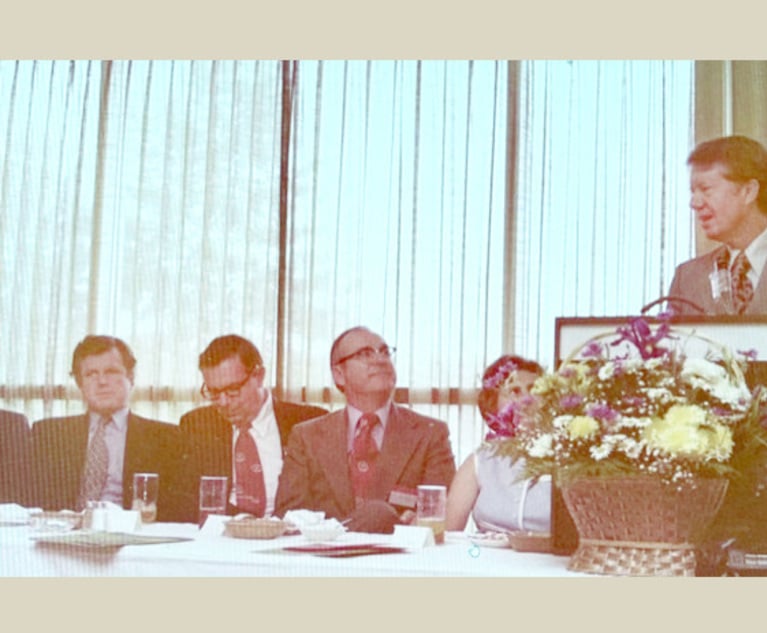 U.S. Department of Justice building in Washington, D.C. Jan. 10, 2012. Photo by Diego M. Radzinschi/THE NATIONAL LAW JOURNAL
U.S. Department of Justice building in Washington, D.C. Jan. 10, 2012. Photo by Diego M. Radzinschi/THE NATIONAL LAW JOURNALNavigating the DOJ's New Guidance on the Evaluation of Corporate Compliance Programs
While noting that DOJ does not use a “rigid formula” to assess the effectiveness of a company's compliance program, the guidance document lays out three “fundamental questions” that a prosecutor should answer.
May 20, 2019 at 12:21 PM
5 minute read
The U.S. Department of Justice recently released a comprehensive guidance document entitled “Evaluation of Corporate Compliance Programs.” The guidance document will assist federal prosecutors to make decisions about whether and to what extent a company's compliance program was effective for the purposes of determining (1), whether criminal charges should be filed against the company; (2), whether and in what amount a fine should be levied against the company; and (3), whether a monitor, or some other compliance obligation, should be imposed on the company. The guidance document offers valuable insight for compliance professionals and reinforces the fact that prosecutors will assign significant weight to compliance programs when determining whether to charge, fine, or impose monitorships on companies that have engaged in wrongdoing.
While noting that DOJ does not use a “rigid formula” to assess the effectiveness of a company's compliance program, the guidance document lays out three “fundamental questions” that a prosecutor should answer:
First: Is the Compliance Program Well-Designed?
Prosecutors should first make a threshold determination about whether a company's compliance program is appropriately designed to detect the types of misconduct that are most likely to occur in the company's line of business. Prosecutors should also examine a company's policies and procedures to ensure that they address key compliance risks and that they are effectively communicated to employees through regular trainings. In addition, prosecutors are instructed to determine whether a company has an “efficient and trusted” system for the confidential reporting of potential violations, as well as for investigating such reports. Finally, prosecutors should determine whether a compliance program includes procedures for performing meaningful due diligence on its third-party business partners and/or acquisition targets.
Second: Is the Compliance Program Implemented Effectively?
Even a well-designed compliance program can be unsuccessful if it is implemented incorrectly. Thus, prosecutors are instructed to determine whether a company's compliance program is “implemented, reviewed, and revised … in an effective manner.” In order to do so, prosecutors should first determine whether management has clearly articulated the company's ethical standards, demonstrated adherence to these standards, and encouraged employees to follow them. Prosecutors should also evaluate whether the employees who are responsible for compliance have sufficient experience, seniority, resources, and autonomy. Finally, prosecutors should assess what happens after compliance issues are detected—that is, whether the company has disciplinary procedures in place, whether these procedures are consistently and effectively enforced, and whether the company's compliance program is adapted or revised, as necessary.
Third: Does the Compliance Program Work In Practice?
One of the most difficult things for a prosecutor to do after misconduct has occurred is to try to determine whether a compliance program was working effectively, especially if the misconduct was not immediately detected. The guidance document notes that “the existence of misconduct does not, by itself, mean that a compliance program did not work or was ineffective at the time of the offense.” In order to assess whether a compliance program was effective at the time that misconduct occurred, prosecutors should consider, “whether and how the misconduct was detected, what investigation resources were in place to investigate suspected misconduct, and the nature and thoroughness of the company's remedial efforts.” Prosecutors should also consider whether and how a company's compliance program “evolved over time to address existing and changing compliance risks.” Prosecutors are also instructed to consider any remedial actions taken by a company in the wake of the discovery of misconduct, including disciplinary actions against violators.
Compliance professionals and company management would be wise to pay attention to DOJ's new guidance. The guidance document is easily the most detailed articulation of how DOJ will analyze corporate compliance programs when determining whether criminal charges, fines, or monitorships are warranted. And it is a reminder to companies of the ever-increasing emphasis that DOJ places on compliance. As Assistant Attorney General Brian Benczkowski noted in a speech announcing the issuance of the guidance document: “The importance of corporate compliance cannot be overstated.”
Notably, the guidance document is instructive not only for those companies that find themselves in DOJ's crosshairs, but also for those companies who are not currently under investigation but are looking to build an effective compliance program that will be viewed favorably in the event of a future investigation. Companies should make every effort to design compliance programs that comport with the factors laid out in the guidance document, and they must recognize that compliance programs should be adapted over time in order to respond to changes in a company's business.
Mary P. Hansen, co-chair of the Drinker Biddle's white collar defense and corporate investigations practice, represents clients in connection with investigations and litigation. She also assists clients with internal investigations and compliance and prevention strategies. Peter W. Baldwin, a former federal prosecutor, defends clients facing white-collar criminal and internal investigations, securities enforcement actions, cybersecurity issues, and other complex civil and criminal litigation matters.
This content has been archived. It is available through our partners, LexisNexis® and Bloomberg Law.
To view this content, please continue to their sites.
Not a Lexis Subscriber?
Subscribe Now
Not a Bloomberg Law Subscriber?
Subscribe Now
NOT FOR REPRINT
© 2025 ALM Global, LLC, All Rights Reserved. Request academic re-use from www.copyright.com. All other uses, submit a request to [email protected]. For more information visit Asset & Logo Licensing.
You Might Like
View All
Switching Positions: US Solicitors General and Climate Change Lawsuits
6 minute read
Jimmy Carter’s 1974 Law Day Speech: A Call for Lawyers to Do the Public Good
14 minute read
Preparing for Measured, Responsible and Reasoned Consumer Welfare Policy
4 minute read
The Marble Palace Blog: The Supreme Court’s Bond With Baseball
Trending Stories
Who Got The Work
Michael G. Bongiorno, Andrew Scott Dulberg and Elizabeth E. Driscoll from Wilmer Cutler Pickering Hale and Dorr have stepped in to represent Symbotic Inc., an A.I.-enabled technology platform that focuses on increasing supply chain efficiency, and other defendants in a pending shareholder derivative lawsuit. The case, filed Oct. 2 in Massachusetts District Court by the Brown Law Firm on behalf of Stephen Austen, accuses certain officers and directors of misleading investors in regard to Symbotic's potential for margin growth by failing to disclose that the company was not equipped to timely deploy its systems or manage expenses through project delays. The case, assigned to U.S. District Judge Nathaniel M. Gorton, is 1:24-cv-12522, Austen v. Cohen et al.
Who Got The Work
Edmund Polubinski and Marie Killmond of Davis Polk & Wardwell have entered appearances for data platform software development company MongoDB and other defendants in a pending shareholder derivative lawsuit. The action, filed Oct. 7 in New York Southern District Court by the Brown Law Firm, accuses the company's directors and/or officers of falsely expressing confidence in the company’s restructuring of its sales incentive plan and downplaying the severity of decreases in its upfront commitments. The case is 1:24-cv-07594, Roy v. Ittycheria et al.
Who Got The Work
Amy O. Bruchs and Kurt F. Ellison of Michael Best & Friedrich have entered appearances for Epic Systems Corp. in a pending employment discrimination lawsuit. The suit was filed Sept. 7 in Wisconsin Western District Court by Levine Eisberner LLC and Siri & Glimstad on behalf of a project manager who claims that he was wrongfully terminated after applying for a religious exemption to the defendant's COVID-19 vaccine mandate. The case, assigned to U.S. Magistrate Judge Anita Marie Boor, is 3:24-cv-00630, Secker, Nathan v. Epic Systems Corporation.
Who Got The Work
David X. Sullivan, Thomas J. Finn and Gregory A. Hall from McCarter & English have entered appearances for Sunrun Installation Services in a pending civil rights lawsuit. The complaint was filed Sept. 4 in Connecticut District Court by attorney Robert M. Berke on behalf of former employee George Edward Steins, who was arrested and charged with employing an unregistered home improvement salesperson. The complaint alleges that had Sunrun informed the Connecticut Department of Consumer Protection that the plaintiff's employment had ended in 2017 and that he no longer held Sunrun's home improvement contractor license, he would not have been hit with charges, which were dismissed in May 2024. The case, assigned to U.S. District Judge Jeffrey A. Meyer, is 3:24-cv-01423, Steins v. Sunrun, Inc. et al.
Who Got The Work
Greenberg Traurig shareholder Joshua L. Raskin has entered an appearance for boohoo.com UK Ltd. in a pending patent infringement lawsuit. The suit, filed Sept. 3 in Texas Eastern District Court by Rozier Hardt McDonough on behalf of Alto Dynamics, asserts five patents related to an online shopping platform. The case, assigned to U.S. District Judge Rodney Gilstrap, is 2:24-cv-00719, Alto Dynamics, LLC v. boohoo.com UK Limited.
Featured Firms
Law Offices of Gary Martin Hays & Associates, P.C.
(470) 294-1674
Law Offices of Mark E. Salomone
(857) 444-6468
Smith & Hassler
(713) 739-1250










